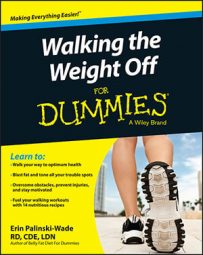Although the intensity and type of walking you may participate in will most likely change and evolve throughout your lifespan, you can maximize your walking workout to increase your calorie burn, boost metabolism, and shed pounds at any age. Think about how you may be able to incorporate the following tips into your daily routine.
Keep good posture. Making sure to keep your head up, your shoulders pulled back and down, and your core tight during exercise not only improves your form, but also activates more muscles during your walk. The harder your muscles work, the more calories they burn.
Increase daily activity as well as scheduled exercise. Adding a structured walk, such as a 30‐minute walk daily, is a great way to lose weight and get in shape. However, some research has found that individuals who perform a structured workout, such as an hour at the gym, but have a mostly sedentary day otherwise, burn less calories than people who are generally up on their feet most of the day.
So do both! Schedule that walk, but make sure you aren’t sitting the rest of the day. If you have a desk job, get up and stretch or walk around every hour or so.
Add interval training. Adding intervals to your walking routine can torch calories as well as boost fitness more rapidly than working out at a consistent intensity level for the duration of the workout. How do intervals work? Take a 20‐minute walk, for instance:
You walk at a moderate 3‐miles‐per‐hour (mph) pace for five minutes, then for one minute you bump up the pace to walk as quickly as you can (for instance, 4 mph), then you bring your speed back down again for five minutes, and repeat over and over again for the duration of the workout. This type of technique helps to elevate your heart rate and keep it elevated for most of your workout, burning more calories.
Power up your walk. Power walking can have many different meanings, but essentially it just means walking at a brisk pace. If you typically walk at a pace where you can comfortably carry on a conversation, this is more of a leisurely walk. By pushing yourself to pump up the pace to where you can still speak but not carry on a full conversation, you are elevating your heart rate and therefore your calorie expenditure.
Don’t be scared of an incline. Walking at an incline, such as walking uphill, can help you to challenge your muscles and boost your calorie burn. If you tend to walk on a flat surface, choosing a different terrain can help turn up your workout and speed up your results.
Adding weights. Adding weights such as hand weights to your walking workout can increase the amount of calories you burn per minute. According to the American Council on Exercise, people who wear light weights during exercise burn approximately 5 to 15 percent more calories on average than people who do not.
The same can be said for adding resistance to your walking workout, such as pushing a stroller. This tactic increases the challenge to your muscles and therefore boosts your calorie burn and your results. If you have any pre‐existing medical conditions, joint issues, prior injuries, or have been diagnosed with osteopenia or osteoporosis, make sure to ask your physician before adding weights if this form of exercise is appropriate for you and any precautions you must take.

